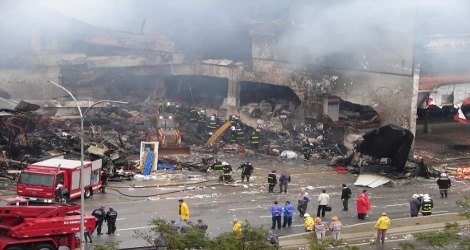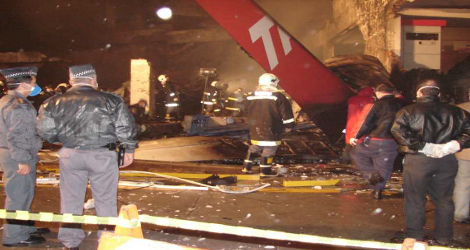On 17 July 2007, at 17:19 local time (20:19 UTC), the Airbus aircraft, model A320, registration PR-MBK, operating as flight TAM Airlines flight JJ3054 , departed from Porto Alegre (SBPA) destined to Congonhas Airport (SBSP) in São Paulo city, São Paulo State.
There were a total of 187 souls on board the aircraft, being six active crew members and 181 passengers, including 2 infants and 5 extra crew members (not on duty).

TAM AIRLINES flight JJ3054
The weather prevailing along the route and at the destination was adverse, and the crew had to make a few deviations. Up to the moment of the landing, the flight occurred within the expected routine.
The TAM Airlines flight JJ3054 was operating with the number 2 engine reverser de-activated, in accordance with the Minimum Equipment List (MEL).
According to information provided to the TWR by crews that had landed earlier, the active runway at Congonhas (35L) was wet and slippery.
During the landing, at 18:54 local time (21:54 UTC), the crew noticed that the ground spoilers had not deflected, and the aircraft, which was not slowing down as expected, veered to the left, overran the left edge of the runway near the departure end, crossed over the Washington Luís Avenue, and collided with a building in which the cargo express service of the very operator (TAM Express) functioned, and with a fuel service station.
All the persons onboard TAM Airlines flight JJ3054 perished. The accident also caused 12 fatalities on the ground among the people that were in the TAM Express building.
The TAM Airlines flight JJ3054 was completely destroyed as a result of the impact and of the raging fire, which lasted for several hours.
The accident of TAM Airlines flight JJ3054 caused severe damage to the convenience shop area of the service station and to some vehicles that were parked there.
The TAM Express building sustained structural damages that determined its demolition.
- Both pilots held valid Medical Certificates (CCF);
- Both pilots held valid Technical Qualification Certificates (CHT) and IFR ratings;
- Both pilots were qualified and, according to the legislation then in force, had the necessary experience to conduct the flight;
- The aircraft had valid Registration and Airworthiness Certificates;
- The maintenance services were considered periodic and appropriate;
- Starting with the departure from Porto Alegre up to the landing at Congonhas, the aircraft had been within the limits of weight and balance established for the operation;
- The aircraft of TAM Airlines flight JJ3054 had the number 2 engine reverser deactivated, in accordance with the procedures established in the MEL;
- The parameters with which the aircraft was dispatched were within the operational envelope of the aircraft
The growth of the operator accentuated the effects of the lack of coordination among its diverse sectors, hindering the oversight at all management levels;
- The preventative tools were not well utilized by the operator;
- The operator’s maintenance control system allowed postponing corrective actions without an appropriate evaluation of the risk relative to the association of failures;
- The operator was not able to retrieve all the copies of the maintenance records destroyed in the accident;
- The communication of recurrent failures and malfunctioning was not being done regularly to the Civil Aviation Authority;
- The prevailing meteorological conditions along the route and at the destination were known to the crew;
- The FWC of the PR-MBK did not possess the improvement introduced by the HF standard;
- The FDR did not record any movement of the thrust lever of the engine nº 2, from the moment it was positioned at “CL” up to the collision of the aircraft;
- The landing occurred with one of the thrust levers at the “IDLE” position and the other one was registered by the FDR as being at the “CL” position;
- The positioning of the nº 2 engine thrust lever in “CL”, while the nº 1 engine thrust lever was in “IDLE”, determined the variation of the parameters of the first engine in trying to maintain the speed previously selected;
- After the landing, there was neither deflection of the ground spoilers, nor activation of the auto-brake
- Approximately six seconds after the touch-down of the main gear, the first activation of the brakes through the pedals occurred, and reached maximum deflection five seconds later;
- For the conditions of operation with an inoperative reverser, wet runway, positioning of a thrust lever in “REV” and the other in “CL”, a distance of more than 2,000 meters would be necessary for a complete stop of the aircraft, without considering the thrust provided by the nº 2 engine;
- The thrust reverser of the A320 can only be activated when: the aircraft is on the ground with both the right and the left landing gear dampers compressed; a channel of the FADEC (Full Authority Digital Engine Control) is operating according to the reverse signal of the corresponding thrust lever; and a signal of the TLA (Thrust Lever Angle) is being validated by, at least, one SEC (Spoiler Elevator Computer);
- The A320 power control system, even with the airplane on the ground (WOW), with the nº 1 engine thrust lever in the “REV” position, with the ground spoilers armed, with the auto brake selected and with application of maximum braking pressure on the pedals, gave priority to the thrust lever in the “CL” position;
- There were no errors in the FDR data recording process;
- There were no failures in the FADEC;
- There were no failures in the TCU (Thrust Control Unit);
- There was no failure in the activating rod which connects the AFU (Artificial Feel Unit) to the TCU, or its connection;
- It was not possible to discard a mechanical failure of the activating rod which connects the thrust lever to the AFU, or a failure of the AFU itself;
- The PIC knew the prescribed procedure for a landing with an inoperative thrust reverser
- The PIC, during the descent, complained that he had a headache
- The SIC’s experience as a co-pilot was limited to the “Right Seat Certification” training;
- In the PR-MBK, there was no alerting system to warn the pilots of an inappropriate setting of the thrust levers
- The “RETARD” auto call-out, during the flight JJ3054, did not comply with the function to which it was designed, since it stopped sounding when one of the thrust levers was at the “REV” position and the other one was at “CL
There are various records of occurrences in which the airplane had an inoperative thrust reverser, and the crew inadvertently placed a thrust lever in the “REV” position with the other one in the “CL” position;
- The A-320 manuals have lots of pages and are hard to consult, mainly during the flight;
- Congonhas Airport was not certified at the time of the accident, in discordance with the RBHA 139;
- The works in the passenger terminal and on the parking ramp completed in 2007 were not homologated;
- No special airport inspection was made during the works conducted at Congonhas Airport and completed in 2007
- No special post-accident airport inspection was made
- Up to the date of the accident, the main runway of Congonhas did not have a RESA;
- The main runway of Congonhas presented, during a long time, a low coefficient of friction and irregularities on its surface which favored the accumulation of water;
- On 10 April 2006, the ANAC recognized the need of the operator to have all the thrust reversers in good working order for the operation in Congonhas with a wet runway condition.
- The inspecting organization did not detect the lack of communication of recurrent failures and malfunctioning prescribed in the RBHA 21 on the part of the operator
- On 29 June 2007, the operations on the main runway of Congonhas were resumed, after the completion of the pavement repair work, but before the grooving was made;
- There was no rain precipitation during the operations in Congonhas between 29 June and 14 July 2007;
- Congonhas airport operated under rain on the days 15, 16 and 17 July 2007;
- On 16 July, a regular transport aircraft had an accident after aquaplaning on the main runway of Congonhas while landing;
- At the moment of the accident with the JJ3054, the volume of precipitation recorded at Congonhas was 0.6 mm;
- On the day of accident, the PR-MBK airplane itself had landed twice on the main runway of Congonhas, the first time at 11:11 am (JJ3701), when the recorded volume of precipitation was 1.5 mm;
- The works carried out in the passenger terminal and on the parking ramp did not formally receive the previous authorization established in the IAC 2328-0790;
- In April 2008, a norm was issued by the ANAC prohibiting the operation at Congonhas with a wet runway if any of the reversers was not available
- The aircraft was completely destroyed.
Download Report


so scary